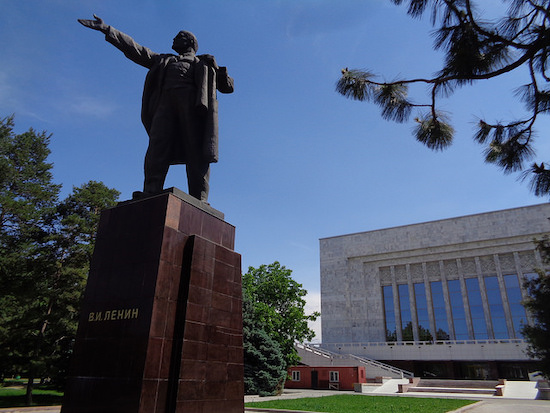In the 1970s, in Frunze, the capital of the Soviet Socialist Republic of Kirghizia, there existed something called the ‘Kollontai Commune’. It passed unknown at the time but was rediscovered by researchers in Bishkek, the renamed capital of independent Kyrgyzstan, in the 2010s, through the collection of materials found in a box among the possessions of a philosophy lecturer. Taking their name from Aleksandra Kollontai, the Bolshevik leader and sexual radical whose ideas on ‘winged eros’ and sexual emancipation were marginalised and then simply ignored from the late 1920s onwards, this small group of Communards communicated with each other through postcards of the buildings of socialist Frunze, which they distributed among themselves. The texts on the back of these postcards used quotations from the ‘classics of Marxism-Leninism’ – Marx, Lenin, Engels’s The Origin of the Family, Private Property and The State – to critique the persistence of the ‘bourgeois family’ into the socialist epoch. They made posters, in which Marx and Engels propound the slogan ‘MAKE WAY FOR COSMIC EROS’, and they wrote texts, which would go further than the ‘classics’, arguing they’d failed to ‘historicise’ gender relations enough – why must ‘love-comradeship’ be between men and women, and not also men and men, and women and women? Why not consider gender itself as historically formed, and hence fluid and changeable?
Alongside this they made architectural drawings of extraordinary lightweight structures floating freely in space, evidently inspired by the ‘Flying City’ of the 1920s architect Georgy Krutikov, but again, going further than even early Soviet culture had dared. The cosmos would be the place for sexual experiment – if we can transcend gravity, we can transcend the family. The researchers, the School of Theory and Activism in Bishkek (the Russian acronym, ‘ShTAB’, also means ‘headquarters’), a pan-Central-Asian collective of Kyrgyz, Tajik, Kazakh and Uzbek thinkers, artists and activists, dubbed the collection they’d found ‘the Frunze Queer Commune’, and made a short film about it, Queer in Space – the Kollontai Commune Archive.
At a public lecture in Moscow organised by an oligarch-backed art foundation in 2015, I saw Georgy Mamedov of ShTAB present their findings, which he saw as part of a ‘Utopian Bishkek’ that had flourished just below the conservative surface of Brezhnev-era Central Asia. His presentation was fascinating, funny, and revelatory – here, finally, was the missing piece of the jigsaw puzzle, the autonomous avant-garde, committed to a Communism I could fully believe in, working in the deep post-colonial periphery of the Soviet Union. This wasn’t about sifting melancholically through the wreckage of an unlamented dead civilisation, or simply conserving 20th century architecture from neoliberal development – generally, the two topics of these sort of events – but was something much, much more exciting. From then on, I read absolutely everything I could from ShTAB, or all that sporadic English texts, my extremely rudimentary Russian and Google Translate could accommodate. This was a heady collection of work. There was a ‘Queer Communist Manifesto’, which had an extremely cogent critique of the limits both of Soviet Communism and Liberalism, arguing that only the synthesis of Queer Communism could transcend them:
“The structural connection between patriarchy and capitalism is becoming more apparent these days, amidst neoliberal reaction – the more cynical forms capitalism takes, the more aggressive patriarchate becomes – using “family values” as a chief means of manipulation. Family – the much valorized “last fortress of love” – works as a fail-proof multifunctional machine for capitalism, providing workforce and enhancing exploitation. One of its functions is transfer of responsibility for social security of vulnerable groups from public institutions to familial, kinship-based, or quasi-communal associations. Indeed, for this purpose strengthening of “blood ties” is essential. The second function of the resurrection of “family values” is production of loyal and apolitical citizenry – patriarchs do not stand on barricades, they have to “feed a family”. Finally, the third function is to reproduce the patriarchal matrix by means of “nurture”. Gender is a binding ingredient in the mortar of capitalism. Women, LGBT, childfree, single, asexual, queer — all carry stigma of unhappiness/deficiency/exoticization under capitalism — stigma that can only be shifted to another group, but never eliminated altogether. Stigma is a constant of capitalism, the working formula of which necessarily includes biopolitical control of birth, life and death. The radical reformatting of gender order – that queer actually denotes – and other forms of togetherness apart from a model of nuclear family, are only conceivable as destigmatised practices on the communist horizon.”
The USSR, committed to Fordism and Functionalism as it was, could never quite escape this logic:
“Here it is important to remember unsuccessful experience of the Bolsheviks, who strove to “liberate women from kitchen slavery” while relying entirely on the enhanced labour productivity and development of means of production. Liberation was expected to come with an advent of new factory-kitchens and ingenious sewing machines, while humans were conceived as simple functions of dependence upon available technical means. Human bodies were defined as “means of production” – production of other bodies and commodities – and that is where “real socialism” (which saw a primary objective of emancipation of women in their increased participation in workforce) concurs with today’s real capitalism, which similarly objectifies and instrumentalises a human. The fact that people produce not only other humans and commodities, but also meanings and affects has not been taken into consideration.”
In Bishkek itself, ShTAB ran tours of ‘Utopian Bishkek’, produced plays and made posters and short films for leftist and LGBT political organisations, but at a distance, all I had were the texts, extraordinary things like one densely theoretical treatise on the work of the late Soviet philosopher Evald Ilyenkov, which claimed him for Queer Communism, for his refusal to see disabled and damaged bodies as ‘inferior’, and for his attention to how ‘the psychological processes which we think of as “natural” and which emerge as it were by themselves are formed by the environment and not at all by some autonomous unfolding of a genetic programme; the theory was interspersed with ‘Queer City’, a series of kaleidoscopic montages ‘showing ten sites in Bishkek related to the history of the LGBT movement in the year 2047’, where the familiar Soviet cityscape has been conjoined with the new, not with the modernising blah that signifies futurism in, say, Astana, but has become instead a city as a continuous Brutalist disco. Interviews in Berlin-published books full of tedious poseurs would feature texts by ShTAB that took completely seriously the Utopian ideas about transcending the existing city, existing society and the existing family expounded in the ’20s; for ShTAB’s Oksana Shatalova, the Queer Communist future would mean developing technology to eliminate ‘natural’ childbirth, and ‘a feminist or rather Queer Dictatorship, where ‘a fundamentally different socialisation and enculturation – without the imposition of depressing male and female ‘destinies’ – will produce another map for the desires of the ‘majority’, or to be more exact, will eliminate this very concept (‘majority’) in relation to sex and sexuality’.
Because of all of this, I decided to make sure I visited ‘Utopian Bishkek’; and in the process of writing this book, I decided that it would end here, where I would write about these self-described Queer Communists, as a real living alternative both to the awful politics of the region – neoliberalism, nationalism, terrified liberalism or nostalgic, bigoted Stalinism – and to the purely reactive, defensive alternatives of melancholy and conservation offered by much activism. I wanted to meet the Kollontai Commune.
What I hadn’t realised is that ShTAB were the Kollontai Commune. Sitting in May 2018, in a bar formed out of an old kindergarten in the courtyard behind 1970s concrete apartment blocks, Georgy Mamedov, unbidden, admitted the ruse. The Kollontai Commune never existed, except in the work of ShTAB themselves. It was a hoax. The artefacts were old postcards and posters found in the second-hand bookshops of Bishkek, which they faked into the ‘archive’. He was particularly keen that the performance be convincing at that oligarch art conference in Moscow – and it certainly was.
But it wasn’t at all intended as a joke on the art world, or on credulous leftist aesthetes, hoping to validate their politics in the Soviet experiment, though it would have been a perfectly judged one if so, but a means of filling in a gap, of inserting into Soviet history something that it ought to have but didn’t. Mamedov claims that since, they’ve found real examples of similar texts and arguments being made, but their circumstances are a little more grim – one really existing Queer Communist they discovered wrote his manifestos in a mental asylum in Leningrad. The invention of the Kollontai Commune was, Mamedov says, part of a long-term programme on the part of ShTAB to assimilate what they could of Soviet socialism – ‘for us’, he said, ‘the Soviet Union didn’t ‘fail”, but was instead a repository of experiences and answers, some good, some awful, to the questions that destroying capitalism would pose – and then go beyond it.
ShTAB itself had ended in the form in which I encountered it a few years earlier – Mamedov had left the group, which was reorganising itself into FEMShTAB, a specifically feminist organisation, while Mamedov was now working for Labrys, an LGBT campaign group in Bishkek, and was abandoning art altogether. On forming, ShTAB had, he told me, a precise plan. First they would aim to understand Soviet Central Asia – first through Utopian Bishkek, a book and a series of maps on technological, proletarian, artistic and architectural utopias whose real traces could be found in the existing city, then through publications philosophical (Queer Communism as Ethics, published by the Free Marxist Press in Moscow), historical and post-colonial (the book Concepts of the Soviet in Central Asia), and then the final part of the plan, where they would move forward into the future, in Completely Different, an anthology of Queer Communist science fiction stories by Central Asian women. Their work as artists and provocateurs was done; what came next, was politics.
The Adventures of Owen Hatherley in the Post-Soviet Space is published by Repeater Books



